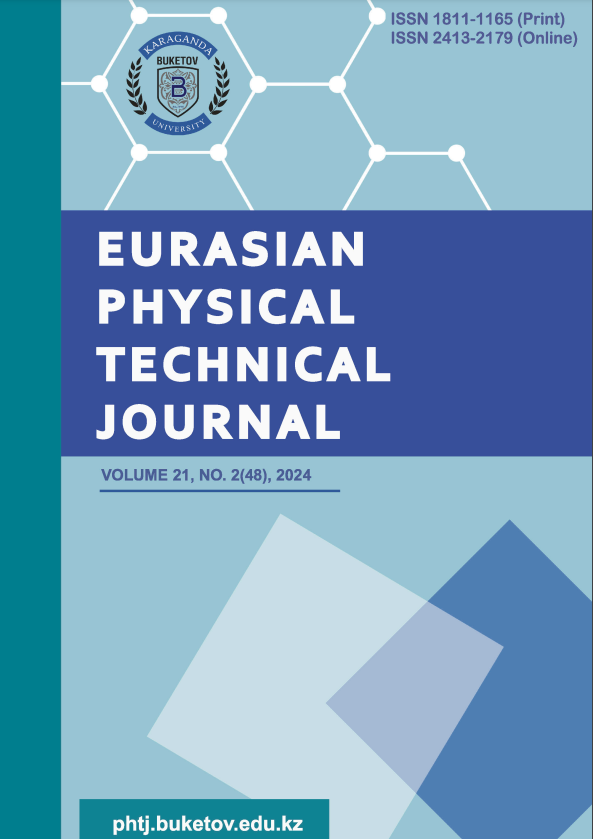SIMULATION OF LIQUID FUEL SPRAY FORMATION AND DISTRIBUTION IN A REACTING TURBULENT FLOW
DOI:
https://doi.org/10.31489/2024No2/22-30Keywords:
fossil fuel, spray, simulation, combustion, injection angle, emissionsAbstract
The paper presentsthe computational experiments of the liquid fuels spray and its droplets distribution in a turbulent reacting flow. Primary and secondary atomization of two types of liquid fuel droplets (isooctane and dodecane) in the presence of combustion was described by the equations of continuity, momentum, internal energy, concentration of components of reacting substances and a two-parameter model for calculating turbulent flow. The study results of the spray, dispersion and combustion of droplets of hydrocarbon liquid fuels in a model combustion chamber when changing the injector injection angle were obtained. The injection angle values varied from 2 to 10 degrees. Based on the computational experiment temperature profiles and concentration characteristics of combustion products and gas in the combustion chamber at various times were obtained. Numerical calculations of the droplets’ Sauter mean diameter distributions have the same dispersion pattern for dodecane. This suggests that the accuracy and adequacy of developed complex model of the formation and distribution of spray in a reacting flow has been confirmed by its strong correlation and good agreement of the modeling results with experimental data from other researchers. This kind of modeling methods and the obtained computational experiments results from them are widely used not only in traditional thermal power engineering, but also in the study of technological processes in the new generation engines chambers, combustion of alternative types of fuels and optimization of their combustion.
References
Bolegenova S., Askarova A., Slavinskaya N., Ospanova Sh., Maxutkhanova A., Aldiyarova A., Yerbosynov D. (2022) Statistical modeling of spray formation, combustion, and evaporation of liquid fuel droplets, Phys. Sci. Technol. 9 (2), 69-82. DOI:10.26577/phst.2022.v9.i2.09.
Gallen L., Riber E., Cuenot B. (2023) Investigation of soot formation in turbulent spray flame burning real fuel. Combust. Flame. 258, 112621. DOI:10.1016/j.combustflame.2023.112621.
Hinrichs J., Schweitzer-De Bortoli S., Pitsch H. (2021) 3D modeling framework and investigation of pollutant formation in a condensing gas boiler. Fuel. 300, 120916.DOI:10.1016/j.fuel.2021.120916.
Report from the Bureau of National Statistics on air protection in the Republic of Kazakhstan (2022). [in Russian]. Available at: https://stat.gov.kz/ru/industries/business-statistics/stat-inno-/publications/68178/
Amsden A.A. (1993) KIVA-3: A KIVA Program with Block-Structured Mesh for Complex Geometries. Los Alamos, 95. Available at: https://www.lanl.gov/projects/feynman-center/deploying-innovation/intellectual-property/software-tools/ kiva/_assets/docs/KIVA3man.pdf
Amsden A.A. (1999) KIVA-3V, RELEASE 2, IMPROVEMENTS TO KIVA-3V. Los Alamos, 34. Available at: https://www.lanl.gov/projects/feynman-center/deploying-innovation/intellectual-property/software-tools/kiva_assets/ docs/KIVA3V.pdf
Gorokhovski M., Hermann M. (2008) Modeling primary atomization. Annu. Rev. Fluid Mech. 40, 343-366. DOI:10.1146/annurev.fluid.40.111406.102200.
Askarova A.S., Bolegenova S.A., Ospanova Sh.S., Rakhimzhanova L.A., Nurmukhanova A.Z., Adilbayev N.A. (2024) Optimization of fuel droplet sputtering and combustion at high turbulence flows. Russ. Phys. J., 67, 2, 167-170. DOI:10.1007/s11182-024-03104-5.
Li Y., Huang Y., Luo K., Liang M., Lei B. (2021) Development and validation of an improved atomization model for GDI spray simulations: Coupling effects of nozzle-generated turbulence and aerodynamic force. Fuel. 299, 120871. DOI:10.1016/j.fuel.2021.120871.
Berezovskaya I.E., Tasmukhanova A.A., Ryspaeva M.Zh., Ospanova Sh.S. (2023) Investigation of the influence of liquid fuel injection rate on the combustion process using KIVA-II software. Eurasian Physical Technical Journal, 20, 3(45), 43–51. DOI:10.31489/2023No3/43-51.
Amsden A.A., O'Rourke P.J., Butler T.D. (1989) KIVA-II: A computer program for chemically reactive flows with sprays. Los Alamos, 160. Available at:https://www.lanl.gov/projects/feynman-center/deploying-innovation/intellectual -property/software-tools/kiva/_assets/docs/KIVA2.pdf
Gorokhovski M., Zamansky R. (2018) Modeling the effects of small turbulent scales on the drag force for particles below and above the Kolmogorov scale. Phys. Rev. Fluids. 3, 034602. DOI:10.1103/PhysRevFluids.3.034602.
Liao Y., Jeng S.M., Jog M.A., Benjamin M.A. (2001) Advanced submodel for airblast atomizers. J. Propul. Power. 17, 2, 411–417. DOI:10.2514/2.5757.
Gorokhovski M.A., Oruganti S.K. (2022) Stochastic models for the droplet motion and evaporation in under-resolved turbulent flows at a large Reynolds number. J. Fluid Mech. 932, 18. DOI:10.1017/jfm.2021.916.
Shen L., Fang G., Wang S., Xing F., Chan Sh. (2022) Numerical study of the secondary atomization characteristics and droplet distribution of pressure swirl atomizers. Fuel. 324, Part B, 124643. DOI:10.1016/ j.fuel.2022.124643.
Askarova A.S., Bolegenova S.A., Maximov V.Yu., Bolegenova S.A., Ospanova Sh.S., Beketayeva M.T., Nugymanova A.O., Pilipenko N.V., Shortanbayeva Zh.K., Baktybekov K.S., Syzdykov A.B. (2018) Investigation of the different Reynolds numbers influence on the atomization and combustion processes of liquid fuel. Bulg. Chem. Commun. 50, 68-77. Available at:http://www.bcc.bas.bg/bcc_volumes/Volume_50_Special_G_2018/50G_PD_68-77.66.pdf
Askarova A., Bolegenova S., Ospanova Sh., Slavinskaya N., Aldiyarova A., Ungarova N. (2021) Simulation of non-isothermal liquid sprays under large-scale turbulence. Phys. Sci. Technol. 8, 28-40. DOI:10.26577/phst.2021.v8.i2.04.
Choi M.,Lee S., Park S. (2023) Numerical and experimental study of gaseous fuel injection for CNG direct injection. Fuel. 140, 693-700. DOI:10.1016/j.fuel.2014.10.018.
Chen L., Sun D., Yang K., Song P., Wang Sh., Zeng W. (2023) Experimental study on the effect of plasma excitation on the atomization characteristics of aviation kerosene transverse jet. Fuel. 332, Part 2, 126210. DOI:10.1016/j.fuel.2022.126210.
Arcoumanis C., Gavaises M. (1998) Linking nozzle flow with spray characteristics in a diesel fuel injection systems. Atom. Sprays. 8, 307–347. DOI:10.1615/AtomizSpr.v8.i3.50.
Downloads
Received
Revised
Accepted
Published online
How to Cite
Issue
Section
License

This work is licensed under a Creative Commons Attribution-NonCommercial-NoDerivatives 4.0 International License.













